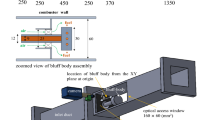Abstract
An OpenFOAM based turbulence combustion solver with flamelet generated manifolds (FGMs) is presented in this paper. A series of flamelets, representative for turbulent flames, are calculated first by a one-dimensional (1D) detailed chemistry solver with the consideration of both transport and stretch/curvature contributions. The flame structure is then parameterized as a function of multiple reaction control variables. A manifold, which collects the 1D flame properties, is built from the 1D flame solutions. The control variables of the mixture fraction and the progress variable are solved from the corresponding transport equations. During the calculation, the scalar variables, e.g., temperature and species concentration, are retrieved from the manifolds by interpolation. A transport equation for NO is solved to improve its prediction accuracy. To verify the ability to deal with the enthalpy loss effect, the temperature retrieved directly from the manifolds is compared with the temperature solved from a transport equation of absolute enthalpy. The resulting FGM-computational fluid dynamics (CFD) coupled code has three significant features, i.e., accurate NO prediction, the ability to treat the heat loss effect and the adoption at the turbulence level, and high quality prediction within practical industrial configurations. The proposed method is validated against the Sandia flame D, and good agreement with the experimental data is obtained.
Similar content being viewed by others
References
VAN OIJEN, J., DONINI, A., BASTIAANS, R., TEN THIJE BOONKKAMP, J. H. M., and DE GOEY, L. State-of-the-art in premixed combustion modeling using flamelet generated manifolds. Progress in Energy and Combustion Science, 57, 30–74 (2016)
PROCH, F. and KEMPF, A. M. Numerical analysis of the Cambridge stratified flame series using artificial thickened flame LES with tabulated premixed flame chemistry. Combustion and Flame, 161, 2627–2646 (2014)
VAN OIJEN, J., LAMMERS, F., and DE GOEY, L. Modeling of complex premixed burner systems by using flamelet-generated manifolds. Combustion and Flame, 127, 2124–2134 (2001)
VREMAN, A., ALBRECHT, B., VAN OIJEN, J., DE GOEY, L., and BASTIAANS, R. Pre-mixed and nonpremixed generated manifolds in large-eddy simulation of Sandia flame D and F. Combustion and Flame, 153, 394–416 (2008)
MA, L. and ROEKAERTS, D. Modeling of spray jet flame under mild condition with non-adiabatic FGM and a new conditional droplet injection model. Combustion and Flame, 165, 402–423 (2016)
RITTLER, A., PROCH, F., and KEMPF, A. M. LES of the Sydney piloted spray flame series with the PFGM/ATF approach and different sub-filter models. Combustion and Flame, 162, 1575–1598 (2015)
CHRIGUI, M., GOUNDER, J., SADIKI, A., MASRI, A. R., and JANICKA, J. Partially premixed reacting acetone spray using LES and FGM tabulated chemistry. Combustion and Flame, 159, 2718–2741 (2012)
EGUZ, U., AYYAPUREDDI, S., BEKDEMIR, C., SOMERS, B., and DE GOEY, P. Manifold resolution study of the FGM method for an igniting diesel spray. Fuel, 113, 228–238 (2013).
WELLER, H. G. and TABOR, G. A tensorial approach to computational continuum mechanics using object-oriented techniques. Computers in Physics, 12, 620–631 (1998)
BARLOW, R. and FRANK, J. Effects of turbulence on species mass fractions in methane/air jet flames. Symposium on Combustion, 27, 1087–1095 (1998)
LILLY, D. K. A proposed modification of the Germano subgrid-scale closure method. Physics of Fluids A: Fluid Dynamics, 4, 633–635 (1992)
BILGER, R. W. The structure of turbulent nonpremixed flames. Symposium on Combustion, 22, 475–488 (1989)
VAN OIJEN, J. A. Flamelet-Generated Manifolds: Development and Application to Premixed Laminar Flames, Technische Universiteit Eindhoven, Eindhoven (2002)
VERVISCH, L., HAUGUEL, R., DOMINGO, P., and RULLAUD, M. Three facets of turbulent combustion modelling: DNS of premixed V-flame, LES of lifted nonpremixed flame and RANS of jet-flame. Journal of Turbulence, 5, N4 (2004)
HAHN, T. Cuba — a library for multidimensional numerical integration. Computer Physics Communications, 168, 78–95 (2005)
PASHAMI, S., ASADI, S., and LILIENTHAL, A. Integration of OpenFOAM flow simulation and filament-based gas propagation models for gas dispersion simulation. Open Source CFD International Conference, Munich, Germany (2010)
XU, B., LIU, Y., and XIE, R. Large eddy simulation of a realistic gas turbine combustor. ASME Turbo Expo 2016: Turbomachinery Technical Conference and Exposition, American Society of Mechanical Engineers, New York (2016)
MATHEY, F., COKLJAT, D., BERTOGLIO, J. P., and SERGENT, E. Assessment of the vortex method for large eddy simulation inlet conditions. Progress in Computational Fluid Dynamics An International Journal, 6, 58–67 (2006)
Author information
Authors and Affiliations
Corresponding author
Additional information
Citation: LI, T., KONG, F. F., XU, B. P., and WANG, X. H. Turbulent combustion modeling using a flamelet generated manifold approach—a validation study in OpenFOAM. Applied Mathematics and Mechanics (English Edition) 40(8), 1197–1210 (2019) https://doi.org/10.1007/s10483-019-2503-6
Project supported by the Strategic Priority Research Program of the Chinese Academy of Sciences (No. XDA 21060102) and Guangdong Provincial Key Laboratory of New and Renewable Energy Research and Development of China (No. y809jh1001)
Rights and permissions
About this article
Cite this article
Li, T., Kong, F., Xu, B. et al. Turbulent combustion modeling using a flamelet generated manifold approach — a validation study in OpenFOAM. Appl. Math. Mech.-Engl. Ed. 40, 1197–1210 (2019). https://doi.org/10.1007/s10483-019-2503-6
Received:
Revised:
Published:
Issue Date:
DOI: https://doi.org/10.1007/s10483-019-2503-6




